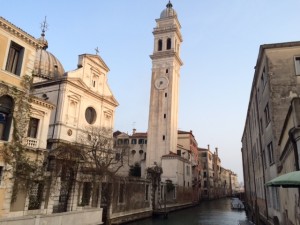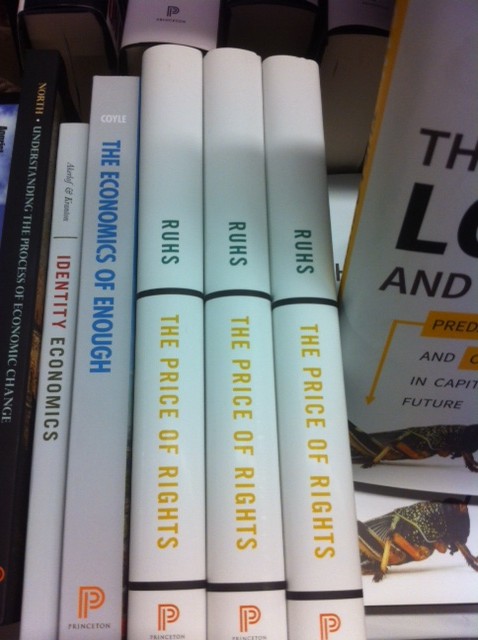Greater international migration has been one of the features of post-1990 globalization, but most people do not leave their homeland to work and live elsewhere. The costs of doing so are high: leaving behind families and social networks, learning to cope with a new environment and usually new language, finding a new place to live, taking the risk of having to find work – and, as Martin Ruhs’s new book, [amazon_link id=”0691132917″ target=”_blank” ]The Price of Rights[/amazon_link], observes, migrants usually do not have the same workplace rights as local workers. Their rights fall below those set in international standards.
[amazon_image id=”0691132917″ link=”true” target=”_blank” size=”medium” ]The Price of Rights: Regulating International Labor Migration[/amazon_image]
The book discusses both the evidence on migrant rights, and the ethical issues. In particular, it asks whether it would be better to agree a set of ‘core rights’ for migrant workers rather than the very comprehensive set of rights currently enshrined in international rules, but rarely if ever observed. The rationale for this move would be that the character of the rights of migrant workers determines their economic effects – how productive they are, how much they compete with or complement the resident workforce, their impact on the public finances. “Because rights shape the effects of labor immigration, migrant rights are in practice a core component of nation states’ labor immigration policies.” Immigration policy has three inter-related elements: the number of migrants, the selection of the type of migrants, and their rights after admission. The first two have been discussed widely, but this book makes a distinctive contribution to the debate by looking carefully at the third. Policy makers pay lip service to universal rights while not ratifying the UN’s convention on migrant worker rights, so the use of the granting of rights (or not) as an instrument of migration policy has not been debated. I also wholeheartedly applaud the inclusion of the ethical issues in the discussion here.
Ruhs constructs some new indicators of the openness of labour migration policies in 46 middle and high income countries. Those countries targeting high skill workers are more likely to grant more extensive social, residency and family rights. The book goes on to describe in more detail the immigration policies of a number of countries. The case studies clearly show that decisions about the granting of rights are considered for their impact on immigrant numbers. The governments of countries sending migrants have sometimes criticise host governments for using rights restrictions as backdoor ‘protection’ – the EU accession countries have voiced this view about the insistence by ‘old’ EU countries on the complete equality of rights for their migrants. Similarly India has tried to use the GATS agreement to argue against wage parity requirements for its migrants overseas on the basis that it is a restriction of trade.
Martin is a former colleague of mine from my days on the Migration Advisory Committee, and the book manifests his measured, pragmatic approach. He writes in the Introduction: “I am skeptical of anybody who maintains that there are obvious or clear answers to any of these issues.” A reasonable voice is more than welcome in this policy debate. He ends up arguing for evidence-based time-limited rights restrictions for migrant workers to enable greater openness to migration (ie. there should be a pathway to permanent residence and equal rights after a period), but is clear that we are in a world of trade-offs. The book is critical of the idealism of people – and UN agencies – advocating both equal and extensive rights for migrant workers and less restriction on migration.
The discussion of the ethics of this approach is very interesting. The book argues that demanding migrant worker ‘rights’ as a universal ethical norm closes the door to reasonable political debate about costs and benefits. When the issue inevitably involves conflicting interests, this is unhelpful – it makes what ought to be negotiable non-negotiable, and raises the temperature politically. Martin writes: “Bringing the state and politics back into rights-based approaches to international labour migration would open up a space for legitimate and important debates and deliberation.”This is an academic book, but very accessible, and I think it is an important one for anybody interested in the migration debate to read.
I also recently read Drew Keeling’s [amazon_link id=”3034011520″ target=”_blank” ]The Business of Transatlantic Migration between Europe and the United States, 1900-1914[/amazon_link], which I believe he will be discussing at the European Historical Economics Society conference taking place in London in the next two days. Here is the book website.
It looks at this historically unique, massive migration flow from the old to the new world through the prism of steamship transportation across the Atlantic: “This is a history of the 11 million European-born migrants who made 19 million ocean crossings on 18,000 voyages of several hundred vessels of two dozen steamship lines.” I found it fascinating to see this movement of people as a transport business, a novel approach to a story that is familiar in many ways. It was a significant business: “The business of migration between Europe and the United States generated over $20 million in revenues for transatlantic steamship companies in 1900, making it one of the largest examples of capitalist enterprise anywhere in the world at that time,” the book begins.
Falling transportation costs and better communications have played a major role in increasing migration during the current era of globalisation. I was surprised to learn that trans-Atlantic passenger fares in the early 20th century did not decline much over time, although there were periods of ‘fare wars’ – the assumption that freight to Europe from the US made space for passengers from Europe is incorrect. The ships used tended to only carry passengers and did not see the same pattern of cost declines as freight traffic.The book argues that the bigger cost to migrants was uncertainty about their prospects, and these costs declined over time as kinship networks in the United States grew more extansive.
Rather, the origins of the passenger steamships lay in state sponsorship of services to carry the mail reliably, the ‘packet’ vessels from the 1820s on. Their reliability and safety increased. The Cunard Line started its regular transatlantic voyages in 1840 with a significant subsidy from the UK government, and took 14 days with little variation – a reduction from earlier sailing times of anywhere between 4 and 8 weeks. This is a terrific business history with lots of fascinating detail about the steamship companies, their business strategies, their interactions with governments, and their risk-mitigation efforts.
It was all brought to a sudden halt by the outbreak of the First World War – one of the first moves by the British government in August 1914 was a blockade that stopped the two big German lines from operating. Migration flows fell sharply and never regained their early 20th century levels. The earlier climate of openness vanished irrevocably – certainly, a century on, it is hard to imagine a return to a population shift on that (relative) scale with such significant consequences for the receiving economy. And while there are certainly business models built on migration, it is hard to imagine they could ever grow into major corporations like Cunard, White Star or HAPAG.
[amazon_image id=”3034011520″ link=”true” target=”_blank” size=”medium” ]The Business of Transatlantic Migration between Europe and the United States, 1900-1914: Mass migration as a transnational business in long distance travel[/amazon_image]


